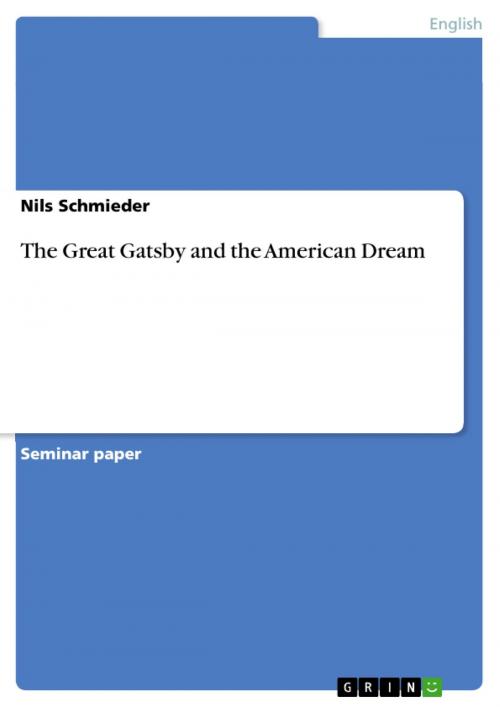| Author: | Nils Schmieder | ISBN: | 9783638498456 |
| Publisher: | GRIN Publishing | Publication: | May 8, 2006 |
| Imprint: | GRIN Publishing | Language: | English |
| Author: | Nils Schmieder |
| ISBN: | 9783638498456 |
| Publisher: | GRIN Publishing |
| Publication: | May 8, 2006 |
| Imprint: | GRIN Publishing |
| Language: | English |
Seminar paper from the year 2006 in the subject American Studies - Literature, grade: 2,3, University of Regensburg (Institut for American Studies), course: American Literatur in the 20th century, 15 entries in the bibliography, language: English, abstract: 'Long before 'America' became a country, it was a continent, and long before it was known to exist as a continent, it was a vision and a dream' (Freese 78). This vision or dream has often been discussed by modernist writers such as F. Scott Fitzgerald. Fitzgerald'sThe Great Gatsbyis a novel about the unconditional love of the self-made man Jay Gatsby to a woman that personifies for him true love, success and the ultimate possession. Yet one of the major themes of his masterpiece is not a disenchanting love relationship, but rather the decline and the corruption of the American Dream. In his novel old values that once gave substance and hope to the Dream have been replaced by immoral and decadent pursuits and virtues, which have eventually corrupted the venerable idea of the American Dream. 'TheGreat Gatsby,we are told, is not simply a chronicle of the Jazz Age but rather a dramatization of the betrayal of the naive American Dream in a corrupt society' (Ornstein 54). It is the thesis of this paper thatThe Great Gatsbyis a comment on the corruption of the American Dream in the Jazz Age of the 1920s, which can be particularly observed in the characters Jordan Baker, Tom and Daisy Buchanan and Jay Gatsby. A short overview of the main assumptions and characteristics of the American Dream will follow the introduction, in particular taking into account Benjamin Franklin's ideas on how to achieve success and wealth in the American society and discussing his proposed thirteen virtues in the Poor Richard's Almanack. Additionally the main ideas that constitute the American dream will be introduced and highlighted. In the third part of the paper these main ideas and Franklin's recipe for success will be applied toThe Great Gatsbyand its characters. Here it will be essential to see, to which extent the characters mentioned above comply with the main ideas and characteristics that compose the idea of the American Dream and its way to success and wealth. Lastly, the conclusion will highlight the results and will prove the thesis, which was raised.
Seminar paper from the year 2006 in the subject American Studies - Literature, grade: 2,3, University of Regensburg (Institut for American Studies), course: American Literatur in the 20th century, 15 entries in the bibliography, language: English, abstract: 'Long before 'America' became a country, it was a continent, and long before it was known to exist as a continent, it was a vision and a dream' (Freese 78). This vision or dream has often been discussed by modernist writers such as F. Scott Fitzgerald. Fitzgerald'sThe Great Gatsbyis a novel about the unconditional love of the self-made man Jay Gatsby to a woman that personifies for him true love, success and the ultimate possession. Yet one of the major themes of his masterpiece is not a disenchanting love relationship, but rather the decline and the corruption of the American Dream. In his novel old values that once gave substance and hope to the Dream have been replaced by immoral and decadent pursuits and virtues, which have eventually corrupted the venerable idea of the American Dream. 'TheGreat Gatsby,we are told, is not simply a chronicle of the Jazz Age but rather a dramatization of the betrayal of the naive American Dream in a corrupt society' (Ornstein 54). It is the thesis of this paper thatThe Great Gatsbyis a comment on the corruption of the American Dream in the Jazz Age of the 1920s, which can be particularly observed in the characters Jordan Baker, Tom and Daisy Buchanan and Jay Gatsby. A short overview of the main assumptions and characteristics of the American Dream will follow the introduction, in particular taking into account Benjamin Franklin's ideas on how to achieve success and wealth in the American society and discussing his proposed thirteen virtues in the Poor Richard's Almanack. Additionally the main ideas that constitute the American dream will be introduced and highlighted. In the third part of the paper these main ideas and Franklin's recipe for success will be applied toThe Great Gatsbyand its characters. Here it will be essential to see, to which extent the characters mentioned above comply with the main ideas and characteristics that compose the idea of the American Dream and its way to success and wealth. Lastly, the conclusion will highlight the results and will prove the thesis, which was raised.















